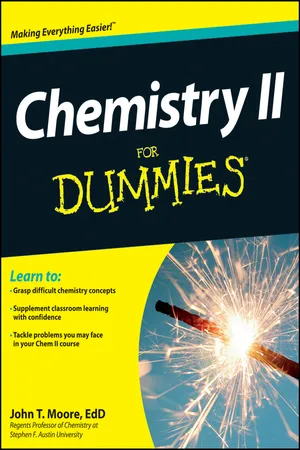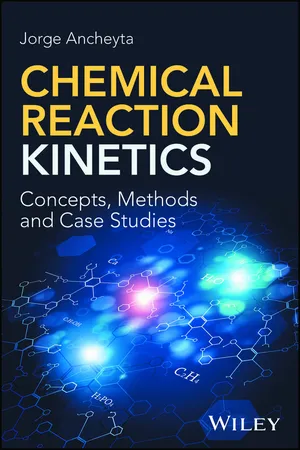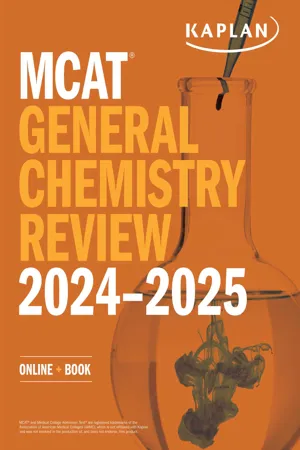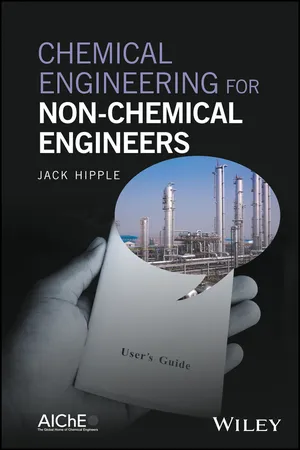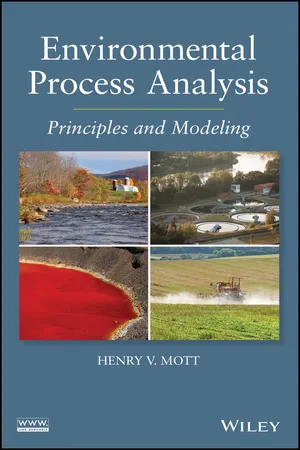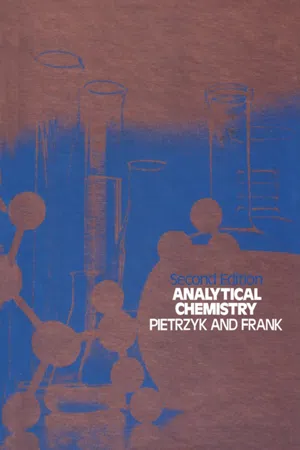Chemistry
Stoichiometry in Reactions
Stoichiometry in reactions refers to the quantitative relationship between the amounts of reactants and products in a chemical reaction. It involves using balanced chemical equations to determine the mole ratios of substances involved in the reaction. This allows for the calculation of the amount of products formed from a given amount of reactants, and vice versa.
Written by Perlego with AI-assistance
Related key terms
Related key terms
1 of 4
Related key terms
1 of 3
10 Key excerpts on "Stoichiometry in Reactions"
- eBook - ePub
Open-Ended Problems
A Future Chemical Engineering Education Approach
- James Patrick Abulencia, Louis Theodore(Authors)
- 2015(Publication Date)
- Wiley-Scrivener(Publisher)
The term stoichiometry refers to this phenomenon, which is sometimes called the chemical law of combining weights. The reaction equation for the combining of hydrogen and oxygen is (3.8) In chemical reactions, atoms are neither generated nor consumed, merely rearranged with different bonding partners. The manipulation of the coefficients of a reaction equation so that the number of atoms each element on the left of the equation is equal to that on the right is referred to as balancing the equation. Once the equation is balanced, the whole number molar ratio that must exist between any two components of the reaction can be determined simply by observation; these are known as stoichiometric ratios. There are three such ratios (not counting the reciprocals) in the above reaction. These are: The unit mole represents either the gmol or the lbmol. Using molecular weights, these stoichiometric ratios (which are molar ratios) may easily be converted to mass ratios. For example, the first ratio above may be converted to a mass ratio by using the molecular weights of H 2 (2.016) and O 2 (31.999) as follows: The mass ratio between the hydrogen and oxygen consumed is therefore These molar and mass ratios are used in material balances to determine the amounts or flow rates of components involved in chemical reactions. Multiplying a balanced reaction equation through by a constant does nothing to alter its meaning. The reaction used as an example above is often written (3.9) In effect, the stoichiometric coefficients of Equation (3.8) have been multiplied by 0.5. There are times, however, when care must be exercised because the solution to the problem depends on the manner or form the reaction is written. This is the case with chemical equilibrium problems and problems involving thermochemical reaction equations - eBook - ePub
- John T. Moore(Author)
- 2012(Publication Date)
- For Dummies(Publisher)
In stoichiometry, the mole concept is essential. The coefficients in the balanced equation are not only the number of individual atoms or molecules but also the number of moles. The ratio of the moles of one substance to another substance in the balanced chemical equation is called a stoichiometric ratio. With this ratio, you can convert from the moles of one substance in a balanced chemical equation to the moles of another substance. And if you can get moles, you can easily generate grams. In order to do any type of stoichiometry problem, you must have the balanced chemical equation. Calculating how many reactants and products Industrial chemists are interested in how much (grams, kilograms, tons, and so on) of a particular product can be formed with a certain amount (grams, kilograms, tons, and so on) of reactants in a certain chemical reaction. The mole concept allows these industrial chemists (and chemistry students) to do this - eBook - ePub
- Jeffrey Gaffney, Nancy Marley(Authors)
- 2017(Publication Date)
- Elsevier(Publisher)
Chapter 4Chemical Equations and Mass Balance
Abstract
This chapter introduces stoichiometry beginning with the mole concept and using Avogadro’s number as a conversion factor between the number of moles and the number of fundamental units in a substance. Case studies are used to present the determination of the empirical and molecular formulas from experimental data. Methods for balancing chemical equations and determining the limiting reactant are covered. The difference between percent yield and atom economy in chemical reactions is discussed in terms of determining the most economical and greener processes, using the steel industry as a Case Study. The process controlling the aqueous solubility of ionic compounds and their influences on precipitation reactions is discussed. The determination of the concentration of aqueous solutions in molarity is also covered.Keywords
Mole; Empirical formula; Chemical equations; Stoichiometry; Limiting reactant; Percent yield; Spectator ions; Solubility; Precipitation reactions; MolarityOutline4.1The Mole4.2The Empirical Formula4.3Chemical Equations4.4Stoichiometry4.5Limiting Reactant and Percent Yield4.6Aqueous Solubility of Ionic Compounds4.7Precipitation Reactions in Aqueous Solution4.8Concentrations in Aqueous SolutionStudy QuestionsProblems4.1 The Mole
Since chemistry deals with the properties of individual atoms and molecules and how these atoms form chemical bonds to create compounds, it is important for chemists to determine the amount of a substance on the molecular scale. Although the common use of the term “amount of substance” used in Engineering may be interpreted as the weight (in grams) or the volume (in cm3 ) of a substance, in chemistry the amount of a substance is a measure of the number of fundamental particles, such as atoms, molecules, or ions that are present in a given mass of substance. The SI base unit for the amount of a substance is the mole . The exact definition of a mole is the mass of any substance, which contains the same number of fundamental units as there are atoms in exactly 12.000 g of 12 C. Carbon-12 was chosen to serve as the reference standard of the mole unit for the International System of Units since it was also chosen to serve as the reference standard for atomic mass and the atomic mass unit, as described in Chapter 1 - eBook - ePub
Principles of Chemical Engineering Processes
Material and Energy Balances, Second Edition
- Nayef Ghasem, Redhouane Henda(Authors)
- 2014(Publication Date)
- CRC Press(Publisher)
5Material Balances on Reactive SystemsChapter 4 dealt with material balances on single- and multiunit systems with no chemical reactions. Normally, reactor is at the heart of chemical processes. In this chapter, first the concepts of stoichiometry as it relates to the material balance are discussed. Then, the application of the reactor in reactive systems is formulated. Next, the different types of balances are described, namely, the element material balance method and the molecular species method. As a special application, material balance on combustion systems is thoroughly discussed.Learning Objectives
- Write a balanced chemical reaction and use stoichiometry to determine the corresponding amounts of participants in a reaction (Section 5.1 ).
- Understand the formulations of the material balance (Section 5.2 ).
- Write balance equations based on the extent of reaction (Section 5.3 ).
- Write balance equations involving atomic species (Section. 5.4 ).
- Write balance equations using molecular species (Section 5.5 ).
- Use of the extent of reaction for a system of chemical reactions (Section 5.6 ).
- Use of component balance for a system of chemical reactions (Section 5.7 ).
- Apply the degrees of freedom analysis for a reactive system (Section 5.8 ) .
- Define the features of combustion processes and properly apply material balances on them (Section 5.9 ) .
5.1 Stoichiometry Basics
In the following, reaction stoichiometry is addressed in light of a few concepts that include the stoichiometric equation, stoichiometric coefficients, and stoichiometric ratios [1 ] .5.1.1 Stoichiometric Equation
It is an equation that relates the relative number of molecules or moles of participants (reactants and products) in a chemical reaction. To be valid, the equation must be balanced. For example, the following stoichiometric equation is not balanced: - eBook - ePub
Chemical Reaction Kinetics
Concepts, Methods and Case Studies
- Jorge Ancheyta(Author)
- 2017(Publication Date)
- Wiley(Publisher)
Eq. (1.1) can be transformed as follows (Chopey, 1994):(1.2)or with positive values:(1.3)which can be generalized as:(1.4)where Ai is the chemical formula and υi is the corresponding stoichiometric numbers.Stoichiometric numbers (υi ) are numerically equal to stoichiometric coefficients (a, b, r and s), but they have a negative sign for reactants and positive sign for products.Example 1.1
Determine the stoichiometric coefficients and numbers for the following reaction for synthesis of ammonia:Solution
According to stoichiometry, the stoichiometric coefficients and numbers are:Stoichiometric coefficient Stoichiometric number a = 1 νN2 = −1 b = 3 νH2 = −3 r = 2 νNH3 = 2 1.1.2 Molecularity
Molecularity is defined as the number of molecules of reactants that take part in a chemical reaction. Most of the reactions exhibit a molecularity of one or two, and in rare cases it reaches the value of three (Hill, 1977).Molecularity is an appropriate concept for a process in which a simple or elemental step is occurring. Reactions in which one or several reactants produce one or several products in a simple path are scarce. For complex reactions, it is necessary to know the molecularity of each individual step of the reaction.Based on this concept, the chemical reactions can be classified mainly as mono‐molecular, bi‐molecular and tri‐molecular. A mono‐molecular reaction involves one molecule of reactant. In a bi‐molecular reaction, two molecules of reactants (either the same or different) are combined to form one or more products. Tri‐molecular reactions are rare since they need the simultaneous collision of three molecules to produce one or several products. Examples of the different types or reactions according to their molecularity are shown in Table 1.1 - No longer available |Learn more
MCAT General Chemistry Review 2024-2025
Online + Book
- (Author)
- 2023(Publication Date)
- Kaplan Test Prep(Publisher)
equations are determined using the following steps in order:- Balancing the least common atoms
- Balancing the more common atoms (usually hydrogen and oxygen)
- Balancing charge, if necessary
Applications of Stoichiometry
- Balanced equations can be used to determine the limiting reagent, which is the reactant that will be consumed first in a chemical reaction.
- The other reactants present are termed excess reagents.
- Theoretical yield is the amount of product generated if all of the limiting reactant is consumed with no side reactions.
- Actual yield is typically lower than theoretical yield.
- Percent yield is calculated by dividing actual yield by theoretical yield and converting to a percentage.
Ions
- Like organic chemistry, ions in general chemistry have a system of nomenclature:
- Roman numerals are used for nonrepresentative elements to denote ionic charge.
- –ous endings can also be used to indicate lesser charge, while –ic endings indicate greater charge.
- All monatomic anions end in –ide.
- Oxyanions are given a suffix indicating how oxidized the central atom is. Those that contain a lesser amount of oxygen are given the suffix –ite, and those with a greater amount are given the suffix –ate.
- Oxyanion series with more than two members are given an additional level of nomenclature. The species with the fewest oxygens is given the prefix hypo–, and the species with the most oxygens is given the prefix per
- eBook - ePub
Green Chemistry and Engineering
A Pathway to Sustainability
- Anne E. Marteel-Parrish, Martin A. Abraham(Authors)
- 2013(Publication Date)
- Wiley-AIChE(Publisher)
5
CHEMICAL REACTIONS
5.1 DEFINITION OF CHEMICAL REACTIONS AND BALANCING OF CHEMICAL EQUATIONS
The concept of molecules and compounds was introduced in Chapter 4. Chemists and chemical engineers manipulate compounds to form new materials that achieve a specific goal or purpose. It is of crucial importance that compounds be mixed in the proper ratios so that the desired reaction can be achieved. The relationship between the compound and its atoms is displayed through the molecular formula, and the chemist uses this information to develop a balanced chemical equation that can properly describe the breaking and forming of bonds in chemical reactions.As mentioned in Chapter 4, a chemical reaction is “a process in which substances (reactants) change into other substances (products) by rearrangement, combination, or separation of atoms.” A chemical reaction is represented by a chemical equation with two sides: one for the reactants and one for the products.The arrow means “forms,” “yields,” “changes to,” or “is/are converted into.”The law of conservation of matter, “matter is neither destroyed nor created,” applies to all atoms in a chemical reaction. As a result, a balanced chemical reaction requires that there must be an equivalent number of atoms of each type on both sides of the equation. Consider the reaction between hydrogen and oxygen to form water, as shown in Equation 5.1 .(5.1 )In Equation 5.1 , we have placed a letter in front of each molecule to represent the stoichiometric coefficient, a multiplying number assigned to the species in a chemical equation in order to balance the equation. Now the challenge is to determine what number each letter in Equation 5.1 represents.Let’s suppose we were producing one molecule of water. In this case, there would be one oxygen atom on the right-hand side of the equation, and to have a balanced chemical equation would require that we have one oxygen atom on the left side. But diatomic oxygen is shown on the left side, and it is not possible to have fractional numbers of molecules. So the smallest number of oxygen molecules on the left side would be one. Based on this analysis, let’s tentatively state that m - eBook - ePub
- Jack Hipple(Author)
- 2017(Publication Date)
- Wiley-AIChE(Publisher)
4 Stoichiometry, Thermodynamics, Kinetics, Equilibrium, and Reaction EngineeringWe will now cover several topics that affect some of the practical aspects of scaling up a chemical reaction and the integration of chemistry and chemical engineering.Stoichiometry and Thermodynamics
First, there is the general topic of stoichiometry. This is a word, derived from Greek, which describes the ratio and amounts of chemicals that react with each other in a chemical reaction. Here we must introduce some basic chemistry concepts. Every chemical has a different molecular structure, size, and weight as determined by its molecular content. In the early 1900s, a brilliant Russian chemist, Mendeleev, was able to organize the known chemical elements according to their atomic number, atomic weight, as well as by the nature of their chemical activity. By adding the number of protons in a molecule and the corresponding number of electrons that balance the charge, its atomic number is determined. For example, carbon, C in the table, has an atomic number of 6 and an atomic weight of 12. The table is grouped into types of elements with similar chemical behavior. For example, the “active” metals, such as lithium (Li), sodium (Na), and potassium (K), are in the same column. We see that the halogens fluorine (F), chlorine (Cl), and bromine (Br) are also grouped together. We see the “inert” gases such as helium (He), neon (Ne), argon (Ar), and krypton (Kr) also grouped together. Some gaseous molecules such as nitrogen, oxygen, chlorine, and bromine exist, at normal conditions, as diatomic molecules (N2 , O2 , Cl2 , and Br2 , respectively). In these cases the molecular weight will be twice the atomic weight. For example, the atomic weight of nitrogen is 2 × 14 (its atomic weight) or 28. Chlorine’s would be 71 or 2 × 35.5. These distinctions are important as chemicals react according to their molecular weight, not their atomic weight. In some cases these are the same, but in these cases, they are not. A mole is the amount of a given chemical equal to its molecular weight, expressed in any units that are consistent. For example, one gram mole of diatomic chlorine (Cl2 ) is 71 g, one gram mole of diatomic hydrogen (H2 ) is 2 g, and one gram mole of diatomic nitrogen (N2 ) is 28 g. We could also express these as pound moles if we were working in the English system. A mole is a critical concept to understand as chemicals react as moles, not as weights. Weight is a secondary function, not the primary one. It is possible to produce diatomic molecules monoatomically but only under extreme and unusual conditions (Table 4.1 - eBook - ePub
Environmental Process Analysis
Principles and Modeling
- Henry V. Mott(Author)
- 2013(Publication Date)
- Wiley(Publisher)
We have written it as an irreversible reaction, considering only the forward progress of the reaction. The systems we will consider will involve abundances of reactants dictating that the reactions will proceed forward as written. Further, we will typically consider that component A is the component or specie of interest. Most often in environmental engineering we are concerned with the conversion of a contaminant to less harmful forms. However, we must also be mindful that some contaminants form transformation products that are as hazardous as the contaminant itself or more. We therefore need to develop a means to relate the appearance of products with the disappearance of reactants. If the stoichiometric coefficient of reactant A is nonunity, we can normalize the overall reaction to a mole of A by dividing through the equation by the stoichiometric coefficient of A:Now we define the change in the molar concentration of A as the final minus the initial concentration. The changes in B, C, and D are also related to the initial and final concentrations:Typically [A]initial might be known and [A]final might be specified, or perhaps we would be interested in the converse or other situations. In either case, we can then relate the changes in the number of moles of the other reactants and products to Δ[A].(8.1 )The negative signs in Equation 8.1 arise from the fact that when the reaction proceeds forward as written, Δ[A] and Δ[B] are negative (reactants are transformed into products) while Δ[C] and Δ[D] must be positive (products are created from reactants). This set of stoichiometric relations can be applied to reactions with as few as one reactant and one product or with many more reactants and products than considered in the general reaction. Equation 8.1 may be extended beyond simple changes in the concentrations of the reactants and products to the overall rates of the disappearance of reactants and appearance of products. For a system for which the overall rate of flow is known, the overall rate of reaction R (Mt–1 - eBook - ePub
- Clyde Frank(Author)
- 2012(Publication Date)
- Academic Press(Publisher)
Chapter ThreeStoichiometry
Publisher Summary
All analytical procedures are based on either stoichiometric or nonstoichiometric methods. In a stoichiometric analytical procedure, the constituent whose amount is being measured undergoes a reaction with another substance. Nonstoichiometric methods are based on a measurement of a physical property that changes in proportion to the concentration of the desired constituent. Because many of these physical properties are easily measured with great accuracy, it is necessary to calibrate the procedure. The calibration empirically defines the relationship between the concentration of the desired constituent and the magnitude of the physical property for a given set of conditions. The chapter also explains that wet chemical methods—such as gravimetric and volumetric methods—and certain types of separation techniques are stoichiometric, while most instrumental methods, including optical and electrical techniques, are nonstoichiometric. The three most useful ways of expressing concentration in stoichiometric reactions are molarity, normality, and formality.INTRODUCTION
All analytical procedures are based on either stoichiometric or nonstoichiometric methods.In a stoichiometric analytical procedure the constituent whose amount is being measured undergoes a reaction with another substance or is made to decompose in accordance with a well-defined equation which can be written in terms of reactants (R) and products (P).(3–1)By measuring the amount of any one of the products (PC or PD ) or of the reagent used (RA is the desired constituent and RB is the reacting reagent) the amount of the desired constituent can be calculated by applying the laws of definite and combining proportions.Nonstoichiometric methods are just the opposite, in that exact, well-defined reactions cannot always be written. In most cases nonstoichiometric methods are based on a measurement of a physical property that changes in proportion to the concentration of the desired constituent. Since many of these physical properties are easily measured, often with great accuracy, it only becomes necessary to calibrate the procedure. The calibration empirically defines the relationship between the concentration of the desired constituent and the magnitude of the physical property for a given set of conditions.
Index pages curate the most relevant extracts from our library of academic textbooks. They’ve been created using an in-house natural language model (NLM), each adding context and meaning to key research topics.
Explore more topic indexes
Explore more topic indexes
1 of 6
Explore more topic indexes
1 of 4

